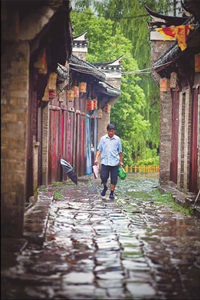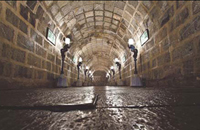 |
Large Medium Small |
Ancient Hefei's grand defence outpost no longer exists but the Three Rivers settlement it was meant to protect thrives to this day. Erik Nilsson reports
The story of ancient Hefei is a tale of two cities - one raised for war, another for peace, one with a history long interred in ruins, while the legacy of the other continues until today.
|
 Residents smile through the rain in Sanhe, an ancient town preserved in its traditional state.
Photos By Jonah m. Kessel
|
While Grand Castle - an outpost built 1,780 years ago to defend the nearby Cao Wei Kingdom (AD 220-265) city of Sanhe - was not destroyed by foreign attacks, it was the very lack of peacetime assaults and the consequent neglect that eventually brought down its walls.
Rather than repelling invading troops, it today attracts armies of tourists who besiege the Park of the Three Kingdoms Ruins, the 35-hectare preservation site built around the ancient bulwark's remains in Anhui's provincial capital.
Grand Castle was constructed near Wei's border with the state of Wu during the Three Kingdoms (AD 220-280) period - a time when a trio of dynasties was deadlocked in a bloody stalemate in their quests to unite and rule China.
The outpost not only withstood 11 attacks from Wu soldiers between AD 230 and 268 but also did so while chalking up huge enemy body counts.
Grand Castle's 6,000 guards defeated more than 100,000 Wu soldiers in AD 234, and 7,000 guards vanquished another 100,000, 19 years later.
After general Sima Yan wrested the Wei throne from the Cao lineage and defeated the other two countries to unite China, the bulwark - no longer needed, as the border it protected no longer existed - was gradually ground into ruins by the sands of time.
Visitors today zip among the remnants in electric carts shaped like vintage cars adorned with Mercedes-Benz hood ornaments. They see the foundations of 18 bases of the 15-meter-high clay city wall, reconstructions of its three gates, and the foundations of a weapons-manufacturing plant and a barrack.
|
 A villager walks through the ancient city of Sanhe.
|
While Grand Castle was abandoned to crumble with the end of war, the nearest settlement it guarded, Sanhe (Three Rivers) city, maintained its functionality until the present day. Consequently, most of the 33,000 inhabitants of the 4.7-sq-km city are descendents of those who founded the community 2,500 years ago.
Sanhe's ancestral citizenry left intact what locals call the "Eight Ancient Relics" - rivers, bridges, villages surrounded by water, streets, teahouses, residences, temple stages and battlefields. The community takes its name from the three waterways that sunder its land - the Hangbu, Fengle and Xiaonan rivers.
These watercourses sire an abundance of freshwater aquatic life, and Sanhe's streets are lined with plastic tubs that roil with eels, shrimps and loaches. The local saying goes: "For a tour, you must go to Huangshan Mountain. To eat, you must come to Sanhe."
The plentitude of water and lack of altitude have a great influence on local life in ways besides providing prolific breeding grounds for aquaculture.
Practically every townsperson in the rainy settlement owns galoshes, and umbrella-jams are commonplace in the narrow alleyways - locally known as "one-person", "two-person" and "three-person" lanes, according to the number of side-by-side pedestrians they can accommodate.
And the high precipitation levels and low topography ultimately render Sanhe prone to flooding. A 1991 flashflood inundated the city with 14.5 meters of water for 73 days.
However, the deluges have failed to destroy the traditional Anhui-style structures, including the city's historically famous residences.
The grandest of these manors is the Old Supermarket, a Republic-era department store that was also home to the then-vice chairman of the local chamber of commerce.
|
 A villager walks through the ancient city of Sanhe.
|
|
 Moisture coats the cold walls and ground of Bao Gong's Tomb in Hefei.
|
The city's wealthiest man used the three-building complex as a residence for his family and servants, as well as a commerce center containing a bank, food market, salt storage facility, jewelry shop and Buddhist temple.
It was also the antiquated nautical equivalent of the town's drive-thru bank, as businessmen would ride boats on the canal to the farthest building to receive financial services.
Sanhe also hosts the former residence of physicist C.N. Yang, who won the 1957 Nobel Prize for his work on statistical mechanics and symmetry principles.
The exhibitions showcasing the life of the first Chinese to earn the honor is complemented with an optical illusions display room, a place where visitors won't - and shouldn't - believe their eyes.
The city also contains the former residence of Kuomintang general Sun Liren, also known as the "Rommel of the East" for defeating the invading Japanese forces in every battle.
But while Sanhe hosts several antiquated buildings of interest, its most magnificent structure is the seven-story National Treasures Museum, constructed in 2001 by a local businessman and his brother.
The establishment houses an extensive collection of relics - furniture, statues and books - spanning the country's history from its early dynasties. Its top floor balcony offers a panorama of the ceramic shingle-plated rooftops that crown the city's ancient dwellings.
Hefei's tourism bureau says these clusters of homes in Sanhe and the remnants of Grand Castle are luring growing numbers of travelers to Anhui's provincial capital. Last year's headcount grew by more than 50 percent year-on-year to 12.12 million.
These figures suggest that the two ancient cities, built when the local cartography was dramatically different, are today helping put their modern successor, Hefei, on the map.